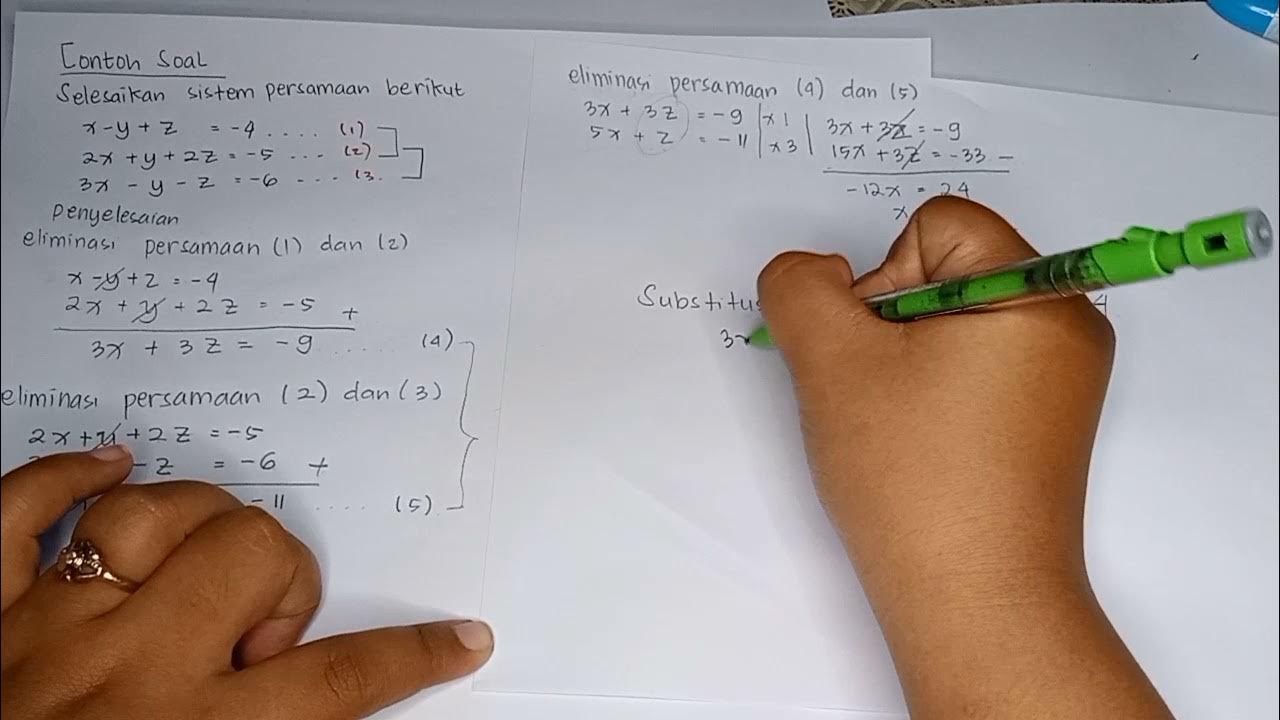Matriks Matematika Kelas 11 • Part 23: Menyelesaikan SPLTV dengan Metode Determinan Matriks
Summary
TLDRThis video from the 'Jendela Sains' channel delves into solving systems of linear equations with three variables using determinants. It explains the concept of determinants for 2x2 matrices and extends it to 3x3 matrices, essential for solving such systems. The tutorial walks through the steps of calculating determinants using the Sarrus' rule and applying them to find the values of variables in a system. It also includes a practical example involving a school library's collection of science, history, and religion books, demonstrating how to set up equations and solve them using determinants.
Takeaways
- 📚 The video discusses solving a system of linear equations with three variables using determinants, specifically focusing on the third-order determinants.
- 🔢 It explains that while two-variable linear systems can be solved using second-order determinants, three-variable systems require third-order determinants.
- 📐 The video introduces the concept of 'Delta', which is the determinant of a 3x3 matrix containing the coefficients of the variables x, y, and z from the equations.
- 📝 It demonstrates the method of calculating 'Delta X', 'Delta Y', and 'Delta Z' by removing the respective variable's coefficients and replacing them with constants from the right-hand side of the equations.
- 👨🏫 The tutorial uses the Sarrus' rule to calculate the determinants, which is a method for finding the determinant of a 3x3 matrix.
- 📘 An example problem is presented involving a school library with a collection of science, history, and religion books, aiming to find the number of each type of book.
- 🔄 The script details the process of setting up equations based on the problem statement and then solving for the variables using the determinant method.
- 🧮 The video shows step-by-step calculations for 'Delta', 'Delta X', 'Delta Y', and 'Delta Z', including the application of Sarrus' rule with the given numbers.
- 📊 It concludes with the solution to the example problem, determining the number of science, history, and religion books in the library.
- 💡 The video emphasizes the practical application of determinants in solving real-world problems, such as inventory management in the context of the example.
Q & A
What is the main topic discussed in the video?
-The main topic discussed in the video is solving systems of linear equations with three variables using determinants of matrices.
What is the significance of determinants in solving systems of linear equations?
-Determinants are used to find the unique solution of a system of linear equations. In the context of the video, they are used to solve a system of three variables.
What is the difference between solving a system of linear equations with two variables versus three variables?
-In the video, it is mentioned that the principle of solving a system of linear equations with two variables is simpler compared to three variables, where determinants of a 3x3 matrix are used instead of a 2x2 matrix.
What are the steps to find the determinant of a 3x3 matrix using the method of Sarrus?
-The steps include calculating the determinant by multiplying the elements of the main diagonal and summing them, then subtracting the sum of the products of the elements of the diagonals that are perpendicular to the main diagonal.
How does the video demonstrate the application of determinants to a real-world problem?
-The video demonstrates the application of determinants by solving a problem involving a school library's collection of science, history, and religion books, where the number of each type of book is unknown.
What is the relationship between the number of science books and history books according to the problem presented in the video?
-The relationship is given as a ratio of 5 to 8, meaning for every 5 science books, there are 8 history books.
How does the video handle the situation where the number of religion books is 100 more than the number of science books?
-The video sets up an equation where the number of religion books (z) is represented as the number of science books (x) plus 100, and then solves for z using determinants.
What is the final outcome of the example problem presented in the video?
-The final outcome is that there are 250 science books, 400 history books, and 350 religion books in the library.
What method does the video recommend for simplifying the process of solving the system of equations?
-The video recommends using the method of Cramer's rule, which involves calculating the determinants of matrices with the coefficients of the variables and then finding the variables by dividing these determinants by the main determinant.
How does the video ensure that the viewers understand the process of solving the system of equations?
-The video ensures understanding by walking through each step of the process, providing clear explanations, and demonstrating the method with a practical example.
Outlines

هذا القسم متوفر فقط للمشتركين. يرجى الترقية للوصول إلى هذه الميزة.
قم بالترقية الآنMindmap

هذا القسم متوفر فقط للمشتركين. يرجى الترقية للوصول إلى هذه الميزة.
قم بالترقية الآنKeywords

هذا القسم متوفر فقط للمشتركين. يرجى الترقية للوصول إلى هذه الميزة.
قم بالترقية الآنHighlights

هذا القسم متوفر فقط للمشتركين. يرجى الترقية للوصول إلى هذه الميزة.
قم بالترقية الآنTranscripts

هذا القسم متوفر فقط للمشتركين. يرجى الترقية للوصول إلى هذه الميزة.
قم بالترقية الآنتصفح المزيد من مقاطع الفيديو ذات الصلة

Solving Systems Using Cramer's Rule

Matematika SMA - Sistem Persamaan Linear (6) - Sistem Persamaan Linear Tiga Variabel (A)

KONSEP SPLTV

Pengertian Sistem Persamaan Linear Tiga Variabel

SISTEM PERSAMAAN LINIER TIGA VARIABEL

SISTEMI LINEARI metodo di CRAMER - la matematica che ci piace, matematica liceo scientifico
5.0 / 5 (0 votes)
